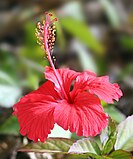
Photo from wikipedia
Ethnopharmacological relevance: Since ancient times, Hibiscus sabdariffa L. calyces have been used as a folk remedy for the treatment of hypertension. However, it is questionable as to whether there is… Click to show full abstract
Ethnopharmacological relevance: Since ancient times, Hibiscus sabdariffa L. calyces have been used as a folk remedy for the treatment of hypertension. However, it is questionable as to whether there is a difference in the antihypertensive activity of the hot or cold aqueous extracts. Aim of the study: We designed this study to specify the best method for water extraction of the antihypertensive metabolites of H. sabdariffa and to confirm their in vivo antihypertensive capabilities. Materials and methods: The powdered dried calyces of H. sabdariffa were independently extracted with cold and hot water. A comparative study was performed between the cold and hot aqueous extracts of H. sabdariffa based on evaluation of the in vitro renin and angiotensin-converting enzyme (ACE) inhibition activities. Additionally, both extracts were subjected to an in vivo study for the evaluation of their antihypertensive activities in L-Nw-Nitro arginine methyl ester (L-NAME)–induced hypertensive rats. Further, a metabolomics study was also performed for both extracts to identify their chemical constituents. Results: The cold and hot extracts significantly reduced the angiotensin II, ACE, and aldosterone levels in the plasma. Furthermore, in the myocardium and aorta, decreased iNOS (inducible nitric oxide synthase) levels and elevated eNOS (endothelial nitric oxide synthase), as well as the rise in plasma NO levels, were reported with both extracts, but better results were displayed with the hot extract, leading to a potential antihypertensive effect. Additionally, the cold and hot Hibiscus extracts induced a cardioprotective effect through reducing necrosis, inflammation, and vacuolization that results from the induction of hypertension, an effect that was more prominent with the hot extract. Moreover, a comprehensive metabolomics approach using ultra-performance liquid chromatography coupled to tandem mass spectrometry (UPLC–MS/MS) was able to trace the metabolites in each extraction. Conclusion: The extracts showed different anthocyanin and phenolic compounds, but the hot extract showed higher contents of specific phenolics to which the superior antihypertensive and cardioprotective activities could be related.
Journal Title: Frontiers in Pharmacology
Year Published: 2022
Link to full text (if available)
Share on Social Media: Sign Up to like & get
recommendations!